
It is safe to say that living in large urban areas, most of the sounds surrounding us are accidental, and most of them are not very pleasant. According to Julian Treasure, chairman of The Sound Agency, sounds can affect us in many ways: physiologically, psychologically, cognitively, and behaviorally, reducing productivity in workspaces and even affecting sales in retail stores. Therefore, paying attention to acoustic comfort in the built environment is imperative, not only for engineers and consultants but also for architects.
As already addressed in this article, indoor acoustic quality is dependent on how well sound sources are controlled. Exterior, interior, impact, and equipment noises are transmitted through the air or building fabric. How the human ear perceives sound directly depends on levels of reverberation and absorption within the building. In this article, we will explore different interior architecture projects and various ways of applying acoustic materials, seeking to understand the options available and the forms of application.
























